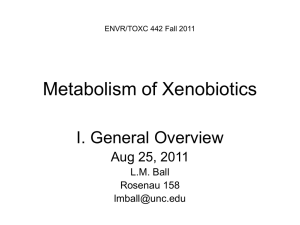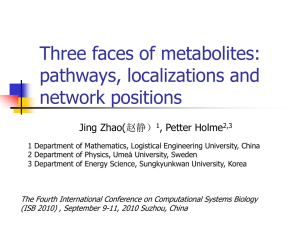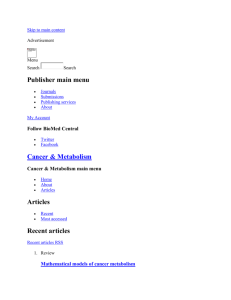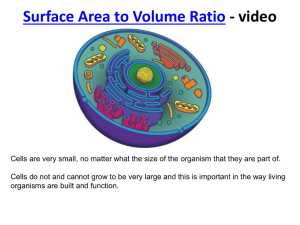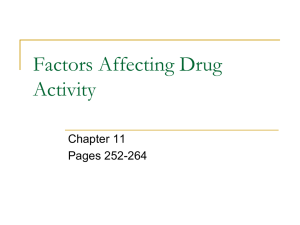Marina Fischer
advertisement
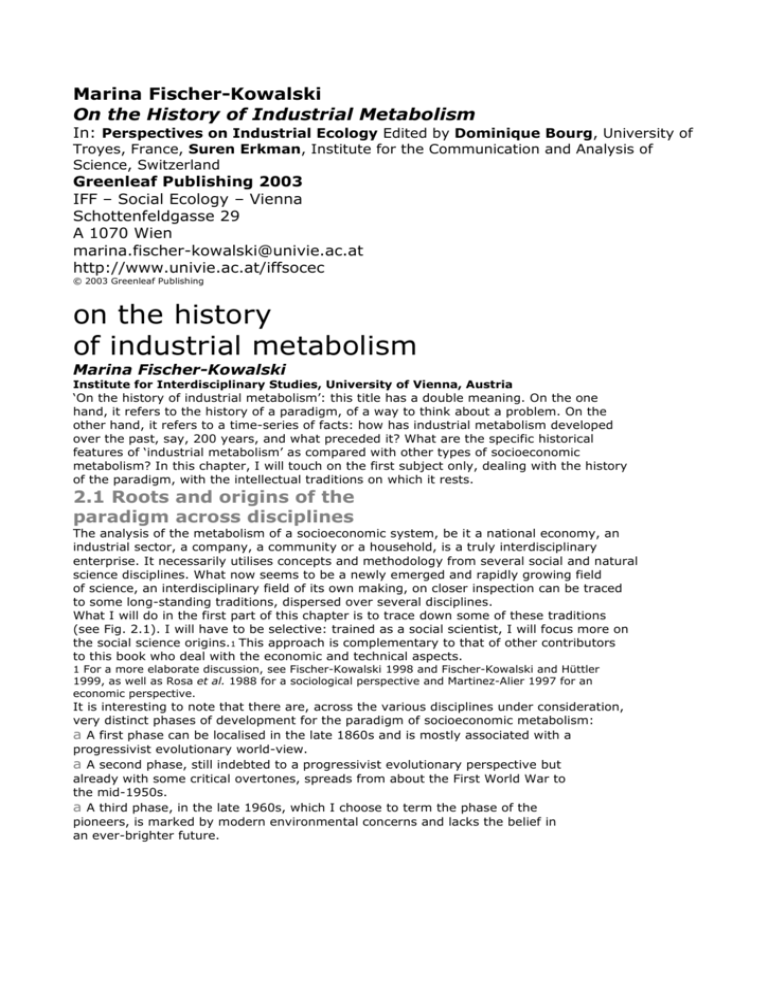
Marina Fischer-Kowalski On the History of Industrial Metabolism In: Perspectives on Industrial Ecology Edited by Dominique Bourg, University of Troyes, France, Suren Erkman, Institute for the Communication and Analysis of Science, Switzerland Greenleaf Publishing 2003 IFF – Social Ecology – Vienna Schottenfeldgasse 29 A 1070 Wien marina.fischer-kowalski@univie.ac.at http://www.univie.ac.at/iffsocec © 2003 Greenleaf Publishing on the history of industrial metabolism Marina Fischer-Kowalski Institute for Interdisciplinary Studies, University of Vienna, Austria ‘On the history of industrial metabolism’: this title has a double meaning. On the one hand, it refers to the history of a paradigm, of a way to think about a problem. On the other hand, it refers to a time-series of facts: how has industrial metabolism developed over the past, say, 200 years, and what preceded it? What are the specific historical features of ‘industrial metabolism’ as compared with other types of socioeconomic metabolism? In this chapter, I will touch on the first subject only, dealing with the history of the paradigm, with the intellectual traditions on which it rests. 2.1 Roots and origins of the paradigm across disciplines The analysis of the metabolism of a socioeconomic system, be it a national economy, an industrial sector, a company, a community or a household, is a truly interdisciplinary enterprise. It necessarily utilises concepts and methodology from several social and natural science disciplines. What now seems to be a newly emerged and rapidly growing field of science, an interdisciplinary field of its own making, on closer inspection can be traced to some long-standing traditions, dispersed over several disciplines. What I will do in the first part of this chapter is to trace down some of these traditions (see Fig. 2.1). I will have to be selective: trained as a social scientist, I will focus more on the social science origins.1 This approach is complementary to that of other contributors to this book who deal with the economic and technical aspects. 1 For a more elaborate discussion, see Fischer-Kowalski 1998 and Fischer-Kowalski and Hüttler 1999, as well as Rosa et al. 1988 for a sociological perspective and Martinez-Alier 1997 for an economic perspective. It is interesting to note that there are, across the various disciplines under consideration, very distinct phases of development for the paradigm of socioeconomic metabolism: a A first phase can be localised in the late 1860s and is mostly associated with a progressivist evolutionary world-view. a A second phase, still indebted to a progressivist evolutionary perspective but already with some critical overtones, spreads from about the First World War to the mid-1950s. a A third phase, in the late 1960s, which I choose to term the phase of the pioneers, is marked by modern environmental concerns and lacks the belief in an ever-brighter future. Natural sciences Social sciences Sociology History Economics Cultural anthropology Society’s metabolism Social geography Materials science Agricultural sciences Biology and ecology Material flow analysis Regulatory mechanisms Energy flow analysis Figure 2.1 Overview of scientific traditions and the study of society’s metabolism: an interdisciplinary concept Subsequently, there followed more than two decades of relative stagnation: the holistic perspective of ‘size’ and ‘growth’ of industrial metabolism receded behind the predominance of pollution and toxicity. In the 1990s, then, there was a virtual explosion of research dealing with industrial metabolism, and the term ‘industrial metabolism’ was (re)born (Ayres and Simonis 1994; Baccini and Brunner 1991; Fischer-Kowalski and Haberl 1993; Lehmann and Schmidt-Bleek 1993) as a powerful unifying concept to relate the functioning of economy and society to its consequences on the environment. But this is just part of the story. Typically, between one phase and the next, the threads were cut, and each author seemed to start anew. It was in the 1860s, when the concept of ‘metabolism’, both as applied to organisms and to human social systems, was born—pretty much at the same time in biology and in social theory. Subsequently, the idea of an energy and materials exchange between society (or, more narrowly, the economy) and the environment as a relevant process, and as an interdependency between social and natural systems, played a role in various social and natural sciences. The term ‘metabolism’, according to present-day standard biological textbooks, refers to the ‘totality of the biochemical reactions in a living thing. These reactions proceed down metabolic pathways’ (Purves et al. 1992: 130; see Fig. 2.2). This more-or-less biochemical notion of metabolism has developed away from the 19th-century concept of metabolism as an exchange of energy and substances between organisms and the environment which, by the writings of Moleschott (1857), had become influential in the social science theory of that time. So the modern biochemical notion of metabolism refers more to the transformative processes of cells, organs and organisms, and does not focus on the environment–organism interface. Ecologists use the term ‘metabolism’ to refer to the energy conversion and nutrient cycling in ecosystems (e.g. Clements 1916; Lotka 1925; Odum 1959, 1969). Among biologists, it is a matter of dispute whether the term ‘metabolism’ may legitimately be used beyond organisms, on the level of ecosystems. Although this dispute is still going on, it is widely accepted that, in effect, biotic communities and ecosystems have self-organising properties that allow them to optimise the utilisation of energy and nutrients (e.g. see Beck et al. 1991). What is common to the biochemical and the ecological approach is the idea of metabolism being a complex self-organising process of autopoietic systems, dependent on the characteristics of this system, and stabilising this system vis-à-vis highly variable environments (Fig. 2.2). So, whether this notion legitimately can be used for the economy of for society in a literal, and not only in a metaphorical sense, depends on the degree of system integration attributed to social systems. Interestingly enough, biologists are very willing to attribute organismic (or system integration) characteristics to the human society where they might deny them to an ecosystem (for an early example, see Tansley 1935: 290; for a critical discussion, see Oechsle 1988). For the early ‘founding fathers’ of social theory (e.g. Marx, Engels, Spencer and Comte) the material society–nature interaction seemed to be an important issue. They readily made use of the biological concepts of their time: Marx and Engels, well acquainted with Moleschott’s writings, were the first to apply the term ‘metabolism’ to society. They shared with most other social scientists of those times an interest in the advances of biology, particularly in evolutionary theory and their implications for universal progress. For Herbert Spencer in his First Principles in 1862, the process of societal advance and the differences in stages of advancement among societies can be accounted for by energy: progress depends on an available energy surplus. The more energy a society is able to consume, the further advanced it is. Societal progress is based on energy surplus. First it enables social growth and thereby social differentiation. Second it provides room for cultural activities beyond basic vital needs. The beginnings of cultural anthropology were, similar to the situation in sociology, marked by evolutionism (as in the works of Morgan 1877, 1963; see Fig. 2.3), and cultural anthropology then split into a more functionalist and a more culturalist tradition. The functionalist line, from which contributions to societal metabolism should be expected, did not, as was the case in sociology, turn towards economics and distributional problems but retained a focus on the society–nature interface. In effect, several conceptual clarifications and rich empirical material on societies’ metabolism can be gained from this research tradition that Orlove (1980), in his critical review, terms ‘ecological anthropology’. The followers of this approach ‘see the social organisation and culture of specific populations as functional adaptations which permit the populations to exploit their environments successfully without exceeding their carrying capacity’ (Orlove 1980: 240). The unit that is maintained is a given population rather than a particular social order (as put forward by sociological functionalists). In contrast to biological ecologists, they treat adaptation not as a matter of individuals and their genetic success but as a matter of cultures. Up to now this research tradition has borne rich fruit that typically is not registered within the industrial ecology research community. In 1864 George Perkins Marsh states in his book Man and Nature that people endanger themselves by destroying their base of subsistence (Fig. 2.4). His main concern is deforestation and the threats of wood scarcity. Marsh was not concerned about the exhaustion of mineral resources. But this was the issue Nathaniel Shaler took up in 1905, worried about the ever-increasing human consumption of mineral resources. One might say this shift of focus from Marsh (1864) to Shaler (1905) reflects the change in society’s metabolism from an agrarian mode of production (where scarcity of food promotes the extension of agricultural land at the expense of forests) to an industrial one, where vital ‘nutrients’ are drawn from subterranean sinks that one day will be exhausted. It reflects it—but it does not reflect on it. In 1955 seventy participants from all over the world and from a great variety of disciplines convened in Princeton, New Jersey, for a remarkable conference: ‘Man’s Role in Changing the Face of the Earth’ (Fig. 2.4). The conference was paying honour to George Perkins Marsh and his book of 1864. It was financed by the Wenner-Gren Foundation for Anthropological Research, and the geographer Carl O. Sauer, the zoologist Marston Bates and the urban planner Lewis Mumford presided over the sessions. The papers and discussions were published in a 1,200-page compendium (Thomas 1956a) that documents, so I would claim, the world’s first interdisciplinary panel on environmental problems of human development, staged by top scientists. This compendium expresses a strong concern with the limited natural base for an explosively rising economic demand for minerals. Such a ‘materials flow’ focus seems to have been strongly supported by wartime experiences and institutions. Ordway (1956: 988) quotes data from a 1952 report of the President’s Materials Policy Commission (Paley Report 1952) worrying about the ‘soaring demand’ for materials. (This report is an excellent source for research into longer time-series of materials consumption, by the way!) The depletion of national resources becomes part of a global concern: ‘if all the nations of the world should acquire the same standard of living as our own, the resulting world need for materials would be six times present consumption’ (Ordway 1956: 988). The bulk of material flow considerations in the 1955 conference is devoted to the input side of metabolism. The overall systemic consideration that the mobilisation of vast amounts of matter from geological sinks (e.g. minerals and fossil energy carriers) into a materially closed system such as the biosphere would change parameters of atmospheric, oceanic and soil chemistry on a global level does not occur yet. Still, many contributions of this conference document the transformations of local and regional natural environments by human activity, both historically and at the time of the conference. Some years later, this tradition was explicitly continued in a further publication, representing the contemporary state of the art of social geography, dating from 1990: The Earth as Transformed by Human Action: Global and Regional Changes in the Biosphere over the Past 300 Years, edited by Turner et al. The global environmental change issue was then taken up by a special issue of Scientific American in September 1970, devoted to the ‘Biosphere’. One year later, Scientific American edited an issue on energy and socioeconomic energy metabolism (Scientific American 1971). In 1969 the German geographer Neef explicitly talked about the ‘metabolism between society and nature’ as a core problem of geography (Neef 1969). But this already belongs to the post-1968 cultural revolution of environmentalism, which we will look at next. 2.2 The pioneers of industrial metabolism in the late 1960s When in the late 1960s it again became culturally possible to take a critical view of economic growth and consider its environmental side-effects, the stage was set for a new twist in looking at socioeconomic metabolism. Up to this point the issue of metabolism had mainly come in as a set of arguments claiming that natural forces and physical processes mattered for the organisation and development of society, that they should be attributed some causal significance for faits sociaux. The mainstream of social science dealing with modern industrial society—whether it be economics, sociology or political science—had not cared about this issue at all. In the mid-1960s this started to change, and, apparently originating from the USA, a set of new approaches developed, often triggered by natural scientists and typically subsequently elaborated in co-operation with social scientists. In these approaches the material and energetic flows between societies (or economies) and their natural environments became a major issue—governed by worries that a ‘cowboy economy’ might not be compatible with a ‘Spaceship Earth’ (Boulding 1966). The common picture of cultural evolution as eternal progress started to give way to a picture of industrial economic growth possibly resulting in a fatal devastation of human life. This has to be looked at as a basic change in world-views, and it took hold of a wide range of intellectuals across many disciplines. And, so I would claim, it promoted something like a rebirth of the paradigm of socioeconomic metabolism, applied to industrial societies. According to Abel Wolman (1965: 179), the water-supply specialist (and participant in the 1955 conference on ‘Man’s Role in Changing the Face of the Earth’): The metabolic requirements of a city can be defined as the materials and commodities needed to sustain the city’s inhabitants at home, at work and at play . . . The metabolic cycle is not completed until the wastes and residues of daily life have been removed and disposed of with a minimum of nuisance and hazard. This serves as the introduction to the first attempt to conceptualise and operationalise the metabolism of industrial society, for the case of a model US city of a million inhabitants (see Fig. 2.5). He is well aware of water being the input needed in by far the highest quantities, but he also offers estimates for food and fossil energy inputs, as well as for (selected) outputs such as refuse and air pollutants. His argument is directed mainly at problems he foresees in the provision of an adequate water supply to US megacities.2 The economist Kenneth Boulding had also been a participant in the 1955 conference. In ‘The Economics of the Coming Spaceship Earth’, Boulding (1966) briefly outlines, with reference to the systems theory of Ludwig von Bertalanffy (1952), an oncoming change from a ‘cowboy economy’ to a ‘spaceman economy’ (Fig. 2.5). The present world economy, according to this view, is an open system with regard to energy, matter and information (an ‘econosphere’). There is a ‘total capital stock, that is the set of all objects, people, organisations and so on’ (Boulding 1966: 5) that has inputs and outputs. Objects pass from the non-economic to the economic set in the process of production, and objects pass out of the economic set ‘as their value becomes zero’ (Boulding 1966: 5). Thus, he says, ‘we see the econosphere as a material process’. This similarly can be described from an energetic point of view. In the ‘cowboy economy’, throughput is at least a plausible measure of the success of the economy: By contrast, in the spaceman economy, throughput is by no means a desideratum, and is indeed to be regarded as something to be minimised rather than maximised. The essential measure of the success of the economy its not production and consumption at all, but the nature, extent, quality and complexity of the total capital stock, including in this the state of the human bodies and minds (Boulding 1966: 9). Here we find one of the first systematic considerations of the material compartments of, as I would say, society (what Boulding calls the econosphere) visualised as an input–output system within the biosphere. Boulding does not, because of his systems approach, confound the economy or society with an ecosystem. In 1969 Bob Ayres, a physicist, and Allen Kneese, an economist, presented the full programme of what was much later, in the 1990s, carried out as material flow analyses of national economies. Their core argument is an economic one: that the economy draws 2 A few years later, Australian human ecologists analysed the metabolism of Hong Kong, concentrating on its ‘bio-metabolism’: that is, its human and animal nutrient cycles, only. A comparison with Sydney (data for the years 1970 and 1971) illustrated a ‘Western-style’ diet, with the same calorific and nutrient benefit for the consumer, to be about twice as wasteful as a diet in the Chinese tradition (see Boyden et al. 1981; Newcombe 1977). heavily on priceless environmental goods such as air and water, goods that are becoming increasingly scarce in highly developed countries, and that this would preclude a Paretooptimal functioning of markets at the expense of those free common goods. They conclude with a formal general equilibrium model to take care of these externalities. In the first part of the paper Ayres and Kneese give an outline of the problem, and they present a first material flow analysis for the USA for the period 1963–65. They claim ‘that the common failure (of economics) . . . may result from viewing the production and consumption processes in a manner that is somewhat at variance with the fundamental law of the conservation of mass’ (Ayres and Kneese 1969: 283). There must occur, they argue, uncompensated externalities unless one of the following three situations prevails: a All inputs of the production process are fully converted into outputs, with no unwanted residuals along the way (or else they all must be stored on the producers’ property) a All final outputs (commodities) are utterly destroyed, made to disappear, in the process of consumption a The property rights are so arranged that all relevant environmental attributes are in private ownership and these rights are exchanged in competitive markets They state that none of these conditions can be expected to hold (Ayres and Kneese 1969: 283): Nature does not permit the destruction of matter except by annihilation with anti-matter, and the means of disposal of unwanted residuals which maximises the internal return of decentralised decision units is by discharge to the environment, principally, watercourses and the atmosphere. Water and air are traditionally free goods in economics. But in reality . . . they are common property resources of great and increasing value . . . Moreover, . . . technological means for processing or purifying one or another type of waste discharge [does] not destroy the residuals but only [alters] their form . . . Thus, . . . [recycling] of materials into productive uses or discharge into an alternative medium are the only general options (Ayres and Kneese 1969: 283). Later, taking us up to the present day, another option came into view: the downsizing of industrial metabolism. 2.3 Lessons learned from the intellectual tradition The first and maybe most important lesson to be learned is the dependence of the organisation of any socioeconomic system on the exchange relations it entertains with natural systems: in other words, on its metabolism. As the intellectual debate teaches, it is not just society and technology that mould the natural environment; it is as much the environment, however modified by human action, that in turn moulds the opportunities and the problems society faces. As the French anthropologist and historian Maurice Godelier put it: Human beings have a history because they transform nature. It is indeed this capacity which defines them as human. Of all the forces which set them in movement and prompt them to invent new forms of society, the most profound is their ability to transform their relations with nature by transforming nature itself (1988: 1f.). The same lesson can be cast as a biological analogy: an organism belonging to a certain species has to sustain a certain metabolism on which its whole internal structure depends. If there is a profound difference in metabolism, there will be a profound difference in the organism itself—it will be the member of another species. So if we wish to change the energetic metabolism of modern industrial societies, for example, we should be aware of the scope of the project. It will not just be a technological task: it will in the end imply profound socioeconomic, historical change. The second lesson I have learned, and I hope the reader can follow me in this, is both the need and the potential of a thoroughly systemic perspective, as the term ‘metabolism’ implies. This concept brings into view the totality of a techno-economic social system within a natural, but also within a socioeconomic, environment. With this picture in mind, many of the fallacies of earlier environmental policy become redundant: you cannot profoundly alter a system’s outputs (i.e. its wastes and emissions) without changing also its inputs and the ways it works internally. Finally, I hope it has become obvious that, to be able to deal with industrial metabolism, social and natural sciences must co-operate intimately. The appeal to co-operation across the ‘great divide’ (Snow 1956) has of late become very popular. The field of industrial ecology seems to be one where this really happens. To put it in the terms of the much-debated French philosopher of science, Bruno Latour: in modern thinking and science, sociocultural ‘subjects’ and natural ‘objects’ were pulled apart to constitute two completely separate realms of reality. However, what modern industrial society constantly does is the opposite: the creation of socio–cultural–natural hybrids. It has to learn to deal with them (see Latour 1991). Reference List Anderson, J.N. 1973. ”Ecological Anthropology and Anthropological Ecology.“ Pp. 179-239 in Handbook of Social and Cultural Antropology, edited by J. J. Honigmann. Chicago: Rand McNally. Ayres, Eugene. 1956. ”The Age of Fossil Fuels.“ Pp. 367-381 in Man’s Role in Changing the Face of the Earth, edited by W. L. Thomas Jr. Chicago: University of Chicago Press. Ayres, Robert U. and Allen V. Kneese. 1968. ”Environmental Pollution.“ in U.S. Congress, Joint Economic Committee: Federal Programs for the Development of Human Resources. Vol. 2. Washington. Ayres, Robert U. and Allen V. Kneese. 1969. ”Production, Consumption and Externalities.“ American Economic Review 59(3):282-297. Ayres, Robert U. and Udo E. Simonis. 1994. Industrial Metabolism: Restructuring for Sustainable Development. Tokyo/New York/Paris. Baccini, Peter and Paul H. Brunner. 1991. Industrial Metabolism: Restructuring for Sustainable Development. Berlin: Springer. Beck, W. S., K. S. Liem and G. G. Simpson 1991. Life. An Introduction to Biology. 3rd ed. New York: Harper Collins. Bertalanffy, Ludwig von. 1952. Problems of Life. New York: Wiley and Sons. Boulding, Kenneth. 1966. ”The Economics of the Coming Spaceship Earth.“ Pp. 3-14 in Environmental Quality in a Growing Economy, edited by K. Boulding et.al. Baltimore: John Hopkins University Press. Boyden, S., S. Millar, K. Newcombe and B. O’Neil. 1981. The Ecology of a City and It’s People: The Case of Hongkong. Camberra: Australian National University Press. Boyden, S. 1992. Biohistory: The Interplay Between Human Society and the Biosphere. Past and Present. Paris: UNESCO - MAB Series and Park Ridge, New Yersey: Panthenon. Bringezu, Stefan. 1995. Neue Ansätze der Umweltstatistik. Ein Wuppertaler Werkstattgespräch. Berlin, Basel, Bostob: Birkhäuser. Clements, F.E. 1916. ”Plant Succession.“ Carnegie Institute Washington Publications 242. Duncan, Otis. D. 1959. ”Human Ecology and Population Studies.“ Pp. 678-716 in The Study of Population, edited by P. M. Hauser and O. D. Duncan. Chicago: Chicago University Press. Enquete-Kommission. 1994. “Schutz des Menschen und der Umwelt” des Deutschen Bundestages (ed.). in Die Industriegesellschaft gestalten - Perspektiven für einen nachhaltigen Umgang mit Stoff- und Materialströmen. Bonn: Economica Verlag. Fischer-Kowalski, Marina and Helmut Haberl. 1997. ”Tons, Joules and Money: Modes of Production and their Suatainability Problems.“ Society and Natural Resources 10(1):61-85. Fischer-Kowalski, Marina, Helmut Haberl, Walter Hüttler, Harald Payer, Heinz Schandl, Verena Winiwarter and Helga Zangerl-Weisz. 1997. Gesellschaftlicher Stoffwechsel und Kolonisierung von Natur. Ein Versuch in Sozialer Ökologie. Amsterdam: Gordon & Beach Fakultas. Fischer-Kowalski, M. 1998. Society's Metabolism. The Intellectual History of Material Flow Analysis, Part I, 1860 1970, in: Journal of Industrial Ecology, Vol. 2, No. 1, 61-78. Fischer-Kowalski, M. and Hüttler, W. 1999. Society's Metabolism: The State of the Art. The Intellectual History of Material Flow Analysis, Part II: 1970-1998, in: Journal of Industrial Ecology, Vol. 2, No. 4, 107-137. Godelier, Maurice 1986. The Mental and the Material: Thought Economy and Society. London: Blackwell Verso. Harris, Marvin. 1991. Cultural anthropology. 3rd ed. New York: Harper & Collins. Kemp, William. B. 1971. ”The Flow of Energy in a Hunting Society.“ Scientific American 224(3):105-115. Kneese, Allen, Robert U. Ayres and Ralph C. D’Arge. 1974. ”Economics and the Environment: A materials Balance Approach.“ Pp. 22-56 in The Economics of Pollution, edited by H. Wolozin. Morristown: General learning Press. Latour, Bruno (1991): Nous n'avons pas jamais été modernes. Essai d'anthropologie symétrique. Paris: Editions la Découverte. Lehmann, H. and Friedrich Schmidt-Bleek 1993. ”Material Flows from a Systematical Point of View.“ Fresenius Environmental Bulletin 2:413-418. Lotka, A. J. 1925. Elements of Physical Biology. Baltimore: Williams & Wilkins. Marsh, Georg P. 1864. Man and Nature; or, Physical Geography as Modified by Human Action. London, New York: Scribners and Sampson Low. Martinez-Alier, Juan. 1987. Ecological Economics. Energy, Environment and Society. Oxford: Basil Blackwell. Maturana, Humberto and Francisco Varela. 1975. Autopoietic Systems. Report BCL 9.4. Urbana, Ill: University of Illinois. Marx, Karl and Friedrich Engels. 1867/1961. Capital. 1. London. McLaughlin, Donald. H. 1956. ”Man's Selective Attack on Ores and Minerals.“ Pp. 851-861 in Man’s Role in Changing the Face of the Earth, edited by William L. Thomas Jr. Chicago: Univ.of Chicago Press. Moleschott, Jakob. 1857. Der Kreislauf des Lebens. Mainz: Von Zabern. Morgan, Lewis. H. 1877/1963. Ancient Society. edited by E. B. Leacock. Cleveland: World. Neef, Ernst. 1969. ”Der Stoffwechsel zwischen Gesellschaft und Natur als geographisches Problem.“ Geographische Rundschau 21:453-359. Netting, Robert McC. 1981. Balancing on an Alp. Ecological Change and Continuity in a Swiss Mountain Community. Cambridge: Cambridge University Press. Newcombe, K. 1977: ”Nutrient Flow in Major Urban Settlement: Hongkong.“ Human Ecology 5(3):179-208. Odum, Eugene P. 1959. Fundamentals of Ecology. 2nd ed. Philadelphia: Saunders. Odum, Eugene. P. 1969. „The Strategy of Ecosystem Development.“ Science 164:262-270. Oechsle, Mechthild. 1988. Der ökologische Naturalismus. Zum Verhältnis von Natur und Gesellschaft im ökologischen Diskurs. Frankfurt, New York: Campus. Ordway, Jr. and H. Samuel. 1956. ”Possible Limits of Raw-Material Consumption.“ Pp. 987- 1009 in Man’s Role in Changing the Face of the Earth, edited by William L. Thomas Jr. Chicago: University of Chicago Press. Orlove, B. S. 1980. ”Ecological Anthropology.“ Annual Review of Anthropology 9:235-73. Paley Report. The President's Materials Policy Commission. 1952. Resources for freedom. 5 vols. Washington, DC: Government Printing Office. Park, Robert E. 1936. ”Human Ecology.“ American Journal of Sociology 42:1-15. [Reprinted in: Park, R.E. (ed) 1952: Human communities: The city and human ecology. New York: Free Press.] Purves, W.K., G. H. Orians and H. C. Heller. 1992. Life. The Science of Biology. 3rd ed. Sunderland, Mass: Sinauer. Rappaport, Roy. 1971. ”The Flow of Energy in an Agricultural Society.“ Scientific American 225(3):117-132. Rosa, Eugene A., Gary E. Machlis and Kenneth M. Keating. 1988. ”Energy and Society.“ Annual Review of Sociology 14:149-72. Schmidt-Bleek, Friedrich. 1993. ”MIPS Revisted.“ Fresenius Environmental Bulletin 2(8):407-412. Shaler, Nathaniel S. 1905. Man and the Earth. New York: Duffield & Co. Sieferle, Rolf P. 1982. Der unterirdische Wald. Energiekrise und industrielle Revolution. München: Beck. Sieferle, Rolf P. 1997b. Rückblick auf die Natur. Eine Geschichte des Menschen und seiner Umwelt. München: Luchterhand. Spencer, Herbert. 1862/1880. First Principles. New York: Burt, A. L. Steward, Julian H. 1968. ”The Concept and Method of Cultural Ecology.“ Pp. 337-344 iInternational Encyclopedia of the Social Sciences, edited by D.L. Sills. New York: Macmillan. Tansley, Arthur G. 1935. ”The use and abuse of vegetational concepts and terms.“ Ecology 16(3):284-307. Thomas, William L. Jr. 1956a. Man's role in Changing the Face of the Earth. Chicago: University of Chicago Press. Thomas, William L. Jr. 1956b. ”Introductory.“ Pp. XXI-XXXVIII in Man's Role in Changing the Face of the Earth, edited by W. L. Thomas. Jr. Chicago: University of Chicago Press. Turner II, B.L., W. C. Clark, R. K. Kates, J. F. Richards, J. T. Mathews and W. B. Meyer. 1990: The Earth as Transformed by Human Action: Global and Regional Changes in the Biosphere over the Past 300 Years. Cambridge: Cambridge University Press. UNO, United Nations Organization. 1993. Integrated Environmental and Economic Accounting. A United Nations Handbook of National Accounting. New York. Vayda, A.P. and R. Rappaport. 1968. ”Ecology, Cultural and Non-Cultural.“ Pp. 476-498 in Introduction to Culural Anthropology, edited by J.A. Clifton. Boston: Houghton Mifflin. Weber, Max. 1909. ”Energetische Kulturtheorien.“ Archiv für Sozialwissenschaften und Sozialpolitik 29:375-402. White, Leslie. 1949. ”Energy and the Evolution of Culture.“ Pp. 363-393 in The Science of Culture. New York: Farrar, Straus, Giroux. Williams, G. C. 1966. Adaption and Natural Selection. Princetown: Princetown University Press. Wolman, Abel. 1965. ”The Metabolism of Cities.“ Scientific American 213(3):178-193. biology and ecology sociology and cultural anthropology Jakob Moleschott (1857): Metabolism is defined as an exchange of energy and substances between organisms and the environment. Concepts: food chain, trophical hierarchy Karl Marx and Friedrich Engels (1867, 1961): ‘Metabolism between man and nature’ is effected by human labour: labour (mediated by technology) transforms ‘nature's material . . . to the wants of man’. Biochemical notion (contemporary biology) Metabolism in cell or organism Purves et al. (1992: 130): ‘Metabolism is the totality of the biochemical reactions in a living thing. These reactions proceed down metabolic pathways . . . , so ordered that the product of one reaction is the substrate for the next. Some pathways synthesise, step-by-step, the important chemical building blocks from which macromolecules are built, others trap energy from the environment, and still others have functions different from these.’ Herbert Spencer (1862) and Lewis H. Morgan (1877, 1963): ‘energetic’ theory of evolution: the more energy a society consumes, the more advanced it is Ecological anthropolgy Leslie White (1949), Julian Steward (1955) and Marvin Harris (1965): Society and culture organise human metabolism (core: nutrition) under given environmental conditions and for a given carrying capacity (regulating population reproduction, food habits, handling of water). Environmental change is a consequence of social metabolism, or, for other reasons, leads to cultural change: ‘cultural evolution’. Ecological notion Frederick E. Clements (1916), Alfred Lotka (1925) and Eugene Odum (1959, 1969) Metabolism in an ecosystem Energy conversion and nutrient cycling in ecosystem evolves and becomes optimised in the course of the maturation of the ecosystem. Commonalities Metabolism = selforganising process of highly complex autopoietic systems, subject to evolution. social geography achievements of the pioneers George Perkins Marsh (1864; Man and Nature): ‘Physical geography as modified by human action’: forests are eliminated as a consequence of the need to feed an ever-growing population. Nathaniel Shaler (1905; Man and the Earth): There are worries about everincreasing human consumption of mineral resources and the possible exhaustion of these resources. Princeton 1955 conference on ‘Man's Role in Changing the Face of the Earth’ (Thomas 1956): There are ‘limits to growth’ as a consequence of a limited geological resource base (Ordway 1956; Ayres 1956; Scarlott 1966; Wolman 1965). ‘Paley Report: President's Materials Policy Commission’ ‘Paley Report’ (Paley Report 1952) Pioneers of material flow analysis: Scientific American 1970: ‘Biosphere’ (substance flows) 1971: ‘Energy’ (energetic metabolism) Turner et al. (1990): ‘The Earth as transformed by human action’ Dominant sociological world-view: nature does not matter for society. Mode of production determines metabolism Abel Wolman (1965) publishes in the Scientific American the first empirical estimate of the metabolism of a model US city. ‘The metabolic requirements of a city can be defined as the materials and commodities needed to sustain the city's inhabitants at home, at work and at play . .The metabolic cycle is not completed until the wastes and residues of daily life have been removed and disposed of with a minimum of nuisance and hazard.’ Kenneth Boulding (1966) stresses the need to change from a ‘cowboy economy’ to a ‘spaceman economy’. ‘Cowboy economy’: open system with plenty of world. Measure of success: high throughput. ‘Spaceman economy’: more of a closed system in a narrow world. Measure of success: quality and complexity of stock (i.e. human bodies and minds). Robert Ayres and Allen Kneese (1968, 1969; Kneese et al. 1974) present the first comprehensive empirical material flow analysis for the USA and relate it to population and GDP. Their core argument is an economic one: that the economy heavily draws from priceless environmental goods such as air and water, goods that are becoming increasingly scarce in highly developed countries, and that this would preclude a Pareto-optimal functioning of markets at the expenses of those free common goods. They conclude with a formal general equilibrium model to take care of these externalities. They claim ‘that the common failure [of economics]. .. may result from viewing the production and consumption processes in a manner that is somewhat at variance with the fundamental law of the conservation of mass’. Thus they propose to ‘view environmental pollution and its control as a materials balance problem for the entire economy’. They anticipate carbon dioxide—for its sheer quantity—would become a major environmental problem(!)

